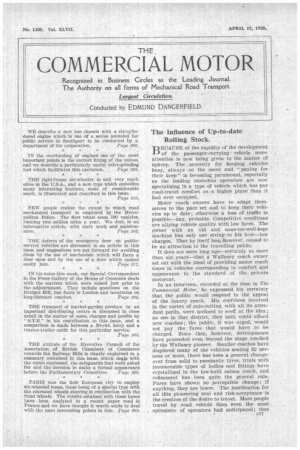The Influence of Up-to-date Rolling Stock.
Page 39

Page 40

If you've noticed an error in this article please click here to report it so we can fix it.
BECAT,JSE of the rapidity of the development of the passenger-carrying. vehicle more attention is now being given to the matter of upkeep. The :necessity for keeping vehicles busy, always on the move and "paying for their keep" is becoming paramount, especially as the leading Motorbus operators are now specializing in a type of vehicle which has -put road-travel comfort on a higher plane than it had ever occupied. Motor coach owners have to adapt themselves to the pace set and to keep their vehicles up to date; otherwise a loss of traffic is possible—nay, probable. Competitive conditions are allying vehicle quality with low fares. The owner with an old and none-too-well-kept machine has only one string to his bow—low charges. That by itself has however, ceased to he an attraction to the travelling public. It does not seem long ago—certainly no more than six years—that a Wallasey coach owner set out with the ideal of providing motor coach. tours in vehicles corresponding in comfort and appearance to the standard of the private motorcar.
In an interview, recorded at the time in The Commercial Motor, he expressed his certainty that the public would respond to the appeal • of the luxury coach, His confreres involved in the vortex of rate-cutting, with all its attendant perils, were inclined to scoff at the. idea ; no one in that district, they said, could afford new coaches; the public, it was urged, would not pay the fares that would have to be charged. Since then, however, developments have proceeded even beyond the stage reached by-the Wallasey pioneer. Smaller coaches have displaced many of the vehicles seating 32 persons or more, there has been a general changeover from solid to pneumatic tyres, trials with innumerable types of bodies and fittings have crystallized in the low-built saloon coach, and refinement has been quite the general rule. Fares have shown no perceptible change; if anything, they are lower. The justification for all this pioneering zeal and risk-acceptance is the creation of the desire to travel. More people • travel by .road vehicle than even the most . optimistic of operators had anticipated; that
number is growing and, we believe, will continue to grow.
There is no reason to ask why, when a com • parative study of the passenger vehicles on the road to-day can tell such an eloquent story. It is beyond question that the vehicle of yesterday is not the vehicle of to-day.
• Skidding : Its Causes and Prevention.
Q OME interesting comments upon the causes I.Jof skidding and means for its prevention have been made recently by the Minister of Transport following certain investigations.
It was rather stating the obvious when reference was made to the fact that the hard and Impervious road surfaces demanded by modern road vehicles are apt to polish under the wear of rubber-tyred wheels, this process being facilitated by the presence of oil dripping from motor vehicles, and that such surfaces, when covered by a film of moisture, afford little resistance to skidding.
Reference was also made to the treatment of such surfaces by suitably heated liquid dressing incorporating the largest possible quantity of sharp, crushed gravel or granite chippings, the best results being obtained by the use of i-in. or g-in. material lightly rolled.
It was pointed out that, whilst it is fairly successful in mitigating the slipperiness both for mechanical and horsed transport, it is recognized that the fundamental causes of skidding have not yet been adequately elucidated, and that much research must be undertaken before It will be possible to determine the respective parts played by the materials and methods of road construction on the one hand and the design of vehicles, tyres, brakes, etc., on the other. In this connection the Ministry of Transport, acting in concert with the National Physical LabOratory, has inaugurated a considerable programme of experiments directed to this end.
So far as experiments with the road surfacings are concerned, we consider this investigation all to the good and vitally necessary, but we do not think that much more can be done in the design of vehicles to assist in reducing their skidding propensities. It is fairly obvious that excessive overhang on a vehicle with a short wheelbase increases the liability to skid, and that a high centre of gravity tending to cause rolling must exercise a considerable effect ; but so far as passenger vehicles are concerned—and the problem with these is of even greater importance than with other types —overhang, wheelbase, etc., are already governed by the Ministry, so that it is hardly a question of expecting the manufacturers to do very much more in the way of co-operation.
Personally, we believe that the modern lowbuilt coach or bus is almost as skidproof as is possible, considering the vehicle alone, and that It is the surface of the road which must receive the fuller attention. On some roads it has been found that practically every make and type of vehicle will skid under certain conditions of road surface, and it is only by increasing the coefficient of friction between tyre and road and the elimination of polished smoothness and of excessive camber that the trouble can be reduced to the minimum.












































































































